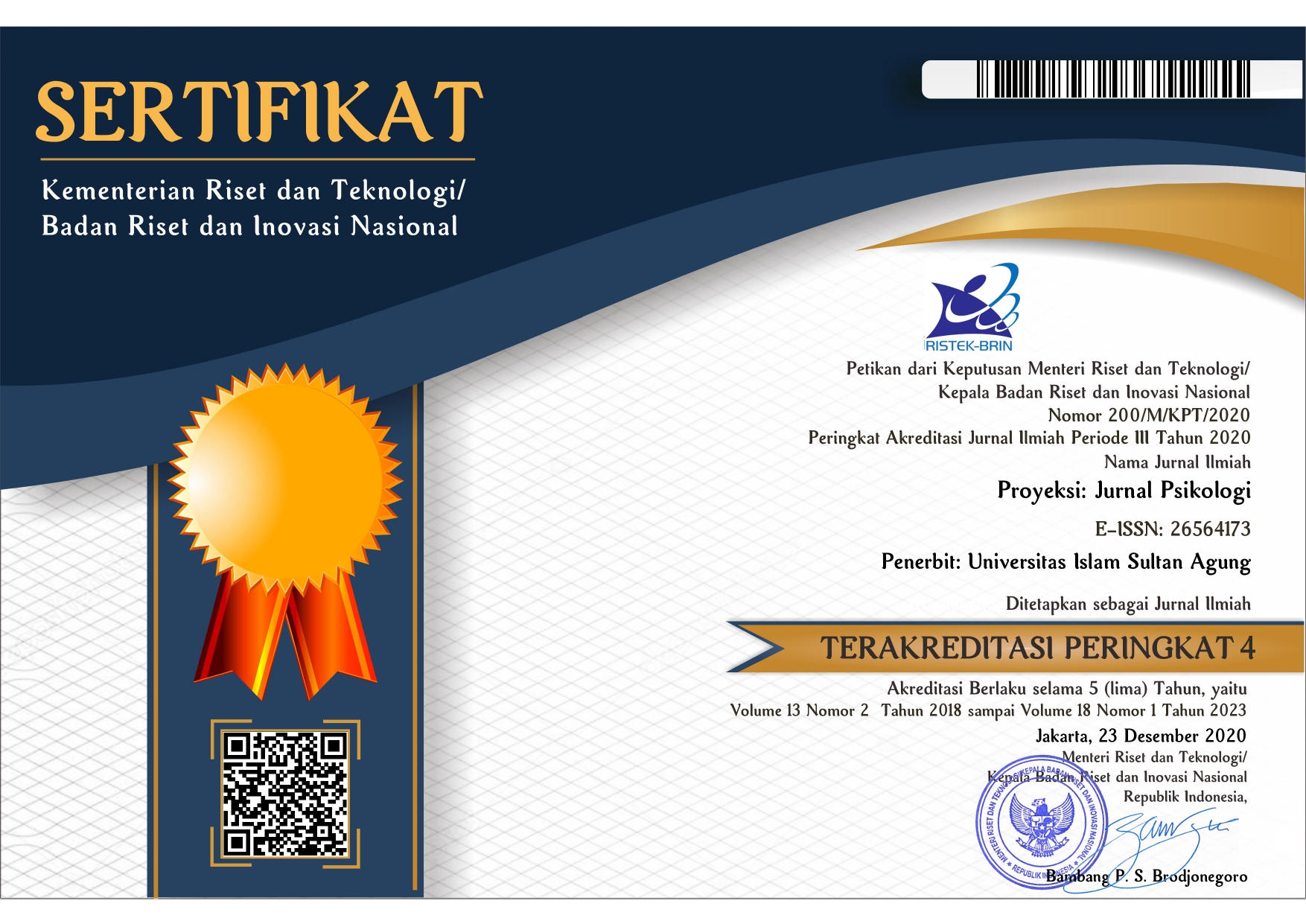HUBUNGAN MINDFULNESS DAN VIGOR DENGAN PRESTASI AKADEMIK PADA MAHASISWA DI UNIVERSITAS X
Abstract
Keywords
Full Text:
PDFReferences
Aikens, K. A., Astin, J., Pelletier, K. R., Levanovich, K., Baase, C. M., Park, Y. Y., & Bodnar, C. M. (2014). Mindfulness goes to work: Impact of an online workplace intervention. JOEM, 56(7): 721-731. DOI: 10.1097/JOM.0000000000000209
Alidina, S. (2010). Mindfulness for dummies. England, UK: John Wiley & Sons
Baer, R. A., Smith, G. T., & Allen, K. B. (2004). Assessment of mindfulness by self-report the kentucky inventory of mindfulness skill. Assessment, 11(1): 191-206.
Baer, R. A., Smith, G. T., Hopkins, J., Krietemeyer, J., & Toney, L. (2006). Using self-report assessment methods to explore facets of mindfulness. Assessment, 13(1): 27-45.
Baer, R. A., Smith, G. T., Lykins, E., Button, D., Krietemeyer, J., Sauer, S., Walsh, E., Duggan, D., & Williams, J. M. G. (2008). Construct validity of the five facet mindfulness questionnaire in meditating and nonmeditating samples. Assessment, 15(3): 329-342.
Carmeli, A., Ben-Hador, B., Waldman, D. A., & Rupp, D. E. (2009). How leaders cultivate social capital and nurture employee vigor: Implications for job performance. Journal of Applied Psychology, 94(6), 1553–1561.
Casuso-Holgado, M. J., Cuesta-Vargas, A. I., Moreno-Morales, N., Labajos-Manzanares, M. T., Barón-López, F. J., & Vega-Cuesta, M. (2013). The association between academic engagement and achievement in health sciences students. BMC medical education, 13, 33. doi:10.1186/1472-6920-13-33
Compton, W. C. (2005). An introduction to positive psychology. Belmont, CA: Wadsworth, a division of Thomson Learning Inc
Crumpacker, Norman. (2017). Relationship between Vigor, Demographic Variables, and Academic Performance. Diunduh dari https://www.researchgate.net/publication/242249806_Relationship_between_Vigor_Demographic_Variables_and_Academic_Performance
Dane, E., & Brummel, B. J. (2013). Examining workplace mindfulness and its relations to job performance and turnover intention. Human Relations, 0(0): 1-24. DOI: 10.1177/0018726713487753
Didonna, F. (2009). Clinical handbook of mindfulness. New York, NY: Springer
Fredrickson B. L. (2004). The broaden-and-build theory of positive emotions. Philosophical transactions of the Royal Society of London. Series B, Biological sciences, 359(1449), 1367–1378
Kemenristekdikti. (2017). Statistik pendidikan tinggi tahun 2017. Jakarta Pusat: Pusat Data dan Informasi Iptek Dikti.
Langer, E. J. (1989). Mindfulness (a merloyd lawrence book). Cambridge, MA: Da Capo Press
Lin, J. W., & Mai, L. J. (2016). Impact of mindfulness meditation intervention on academic performance. Innovations in Education and Teaching International, 55(3), 366–375.
McKenzie, S., & Hassed, C. (2012). Mindfulness for life. Wollombi, NSW: Exisle
Meinarno, E. A. (2019). Berbincang motivasi guna menghadapi kehidupan perguruan tinggi. Buletin K-PIN, 5(13). Diunduh dari https://buletin.k-pin.org/index.php/daftar-artikel/435-berbincang-motivasi-guna-menghadapi-kehidupan-perguruan-tinggi
Munsir, I. (2018). Universitas negeri Makassar do 2.434 mahasiswa dengan ipk rendah. Diunduh dari https://news.detik.com/berita/d-3918688/universitas-negeri-makassar-do-2434-mahasiswa-dengan-ipk-rendah
Naik, P., Harris, V. W., & Forthun, L. F. (2013). Mindfulness: An introduction. Diunduh dari https://www.researchgate.net/publication/261528260_Mindfulness_An_Introduction
Nisfiannoor, M. (2009). Pendekatan statistika modern untuk ilmu sosial. Jakarta: Salemba Humanika
Nurfuadah, R. N. (2015). Penyebab dan solusi nilai kuliah jelek. Diunduh dari https://news.okezone.com/read/2015/10/02/65/1224653/penyebab-dan-solusi-nilai-kuliah-jelek
Rosenstreich, E., & Margalit, M. (2015). Loneliness, mindfulness, and academic achievements: A moderation effect among first-year college students. The Open Psychology Journal, 2015(8): 138-145.
Russell, J. A., & Steiger, J. H. (1982). The structure in persons’ implicit taxonomy of emotions. Journal of Research in Personality, 16(4), 447–469.
Scherer, S., Talley, C. P., & Fife, J. E. (2017). How personal factors influence academic behavior and gpa in african American stem students. Sage Open April-June 2017: 1-14.
Shapiro, S. L., & Carlson, L. E. (2009). The art and science of mindfulness: Integrating mindfulness into psychology and the helping professions,(pp.3-14). Washington, DC, US: American Psychological Association
Shirom, A. (2007). Explaining vigor: on the antecedents and consequences of vigor as a positive affect at work. In D. L. Nelson & C. L. Cooper (Eds.), Positive organizational behavior (pp. 86-100). London: SAGE Publications Ltd
Shirom, A. (2003). Feeling vigorous at work? The construct of vigor and the study of positive affect in organizations. Emotional and Physiological Processes and Positive Intervention Strategies, 135–164.
Shirom, A. (2011). Vigor as a positive affect at work: Conceptualizing vigor, its relations with related constructs, and its anteceents and consequences. Review of General Psychology, 15(1): 50-64.
Susanti, A. (2015). Tingkatkan nilai ipk dengan cara simpel. Diunduh dari https://news.okezone.com/read/2015/12/10/65/1264399/tingkatkan-nilai-ipk-dengan-cara-simpel
Teodorczuk, Krysia & Guse, Tharina & Du Plessis, Graham. (2016). Mindfulness and academic achievement in South African university students. 10.13140/RG.2.1.3307.8169.
DOI: http://dx.doi.org/10.30659/jp.14.2.172-184
Refbacks
- There are currently no refbacks.

Proyeksi by https://jurnal.unissula.ac.id/index.php/proyeksi/ is licensed under a Creative Commons Attribution-ShareAlike 4.0 International License.


